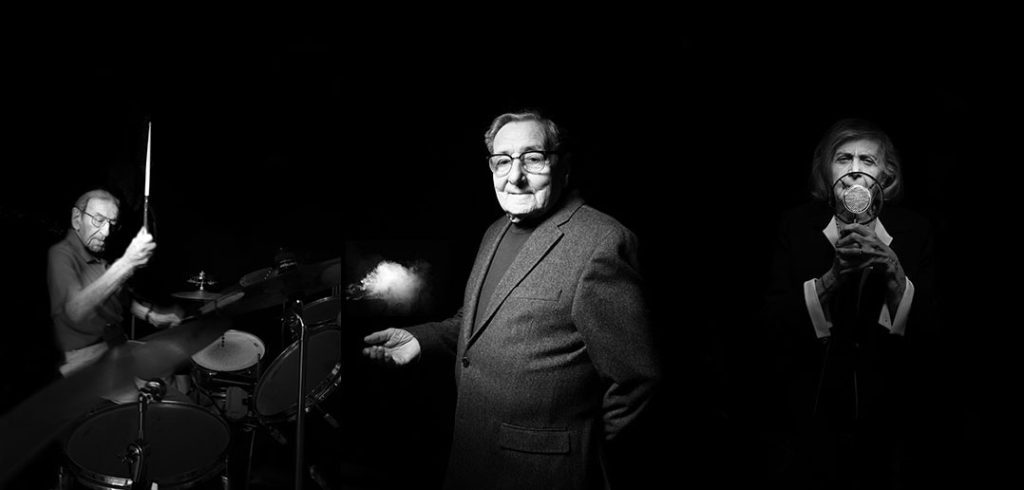Donning a mask, Van Sise, a 2005 Fordham College at Lincoln Center graduate, made himself comfortable in Werner Reich’s living room. For the next two hours, he listened to the 92-year-old engineer talk about life in the United States, his home since 1948, and he watched as the father of two and grandfather of four performed magic tricks. As a teenager, he’d survived three concentration camps, including Auschwitz, the deadliest Nazi death camp. There, he’d learned card tricks to entertain the guards—a skill that had kept him alive. When he finally left the camp, Reich endured a frigid death march and suffered frostbite so severe that he’d later have to amputate a toe.
By the time World War II was over, Reich had no formal education, no home, and both his parents were dead. He was 17 years old and weighed 64 pounds. He had nothing. So he created a new life for himself.
This complete revival was what Van Sise had come to learn about.
After the war, Reich fled to England, where he got himself through high school and married a fellow Holocaust survivor. He and his wife then moved to the United States, where he put himself through college and became an engineer. Through it all, Reich dabbled in magic tricks, a passion that had once kept him alive and now simply brought him joy.
Van Sise was struck by Reich’s vitality, his humor. After they spoke for two hours, Reich posed for a photograph. His silhouette against a black backdrop, he smiled ever so slightly at the camera, his eyes tired but kind, and held out the palm of his hand. After that meeting, Van Sise knew that his journey would continue—and ultimately take the shape of a book.
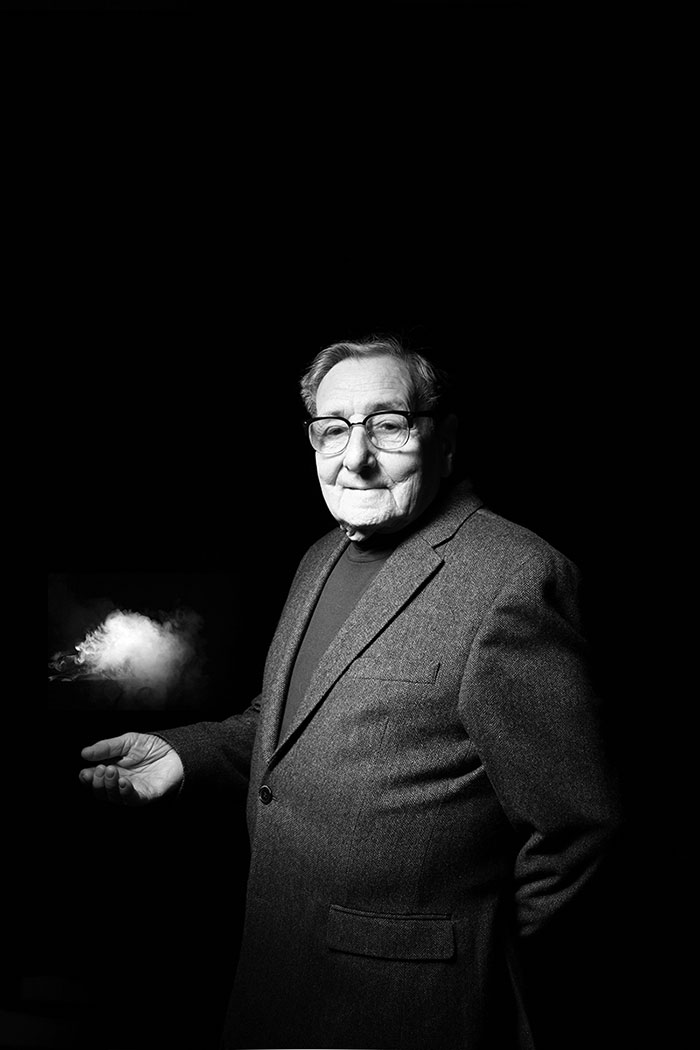
“The experience of meeting survivors was such an unbelievable experience for me—the joy in survivors, the impressive lives they lead, even if sort of the common life,” Van Sise said in February at the launch of his book, Invited to Life: Finding Hope After the Holocaust (Schiffer, 2023). “That became the biggest motivator for me, that greed to absorb this experience, and to be inspired by these people.”
As Van Sise kicked off his road trip during the summer of 2020, COVID-19 cases were peaking and most Americans steered clear of each other if they could help it. And yet Van Sise was on a self-imposed mission that would lead him to the homes of 103 strangers, whose average age hovered around 85.
He’d been warned that no one would want to meet. But this cohort was not the type intimidated by a global pandemic. As children, they had lost family, friends, and homes in a spiral of viscious violence. They’d suffered through the Holocaust—and survived. They were not about to shy away from life now.
They opened their homes to Van Sise, introducing him to their spouses, children, and their children’s children. In turn, Van Sise took every precaution to protect them: from taking multiple COVID tests each week to remaining fully masked during interviews.
‘How Did You Come to Live in America?’
Back in 2015, Van Sise, a photojournalist for The Village Voice, had pitched his editor a photo spread that would document refugees who’d made a life in the United States after World War II. The feature was meant to draw a parallel with the current refugee crisis—the largest since World War II. But the Voice collapsed just around then. Instead, his photographs, a mélange of intimate portraits that tell tales of the human experience with a poet’s sensibility, were exhibited at the Museum of Jewish Heritage and elsewhere.
And Van Sise—a photojournalist, poet, fiction writer, essayist, and wedding photographer who speaks a mile a minute and doesn’t seem to know limits—moved on. “Specialization is for insects,” he said. “I like to keep myself varied in what I do.” He wrote travel essays, humor pieces, short stories, and book reviews. In 2019, he published Children of Grass (Schaffner Press), a collection of portraits that featured notable American poets.
But then COVID set in. A dread of the unknown led to fear and panic, a global paralysis. Van Sise, like much of the country, felt demoralized, a sense of powerlessness he couldn’t shake off. Looking for inspiration, he thought back to the dozen Holocaust survivors he’d photographed a few years back. As he recalled the remarkable personalities he’d encountered, their verve for life, Van Sise decided to revisit the project and find as many Holocaust survivors as possible.
He reached out to Holocaust museums across the country for their help contacting potential subjects. And off he went. After meeting Reich, Van Sise met multiple concentration camps survivors, others who as children had been hidden away for years, or transported to safety—at the expense of leaving their parents behind. They’d all missed much of their childhood due to war. Many lost their parents, grandparents, and siblings. But Van Sise was most interested in what had happened after: the rebuilding of a life.
“There’s been plenty written about the war. I can’t add to that,” said Van Sise. “And nobody ever really asked them about their American lives.”
So he drove his dark blue hatchback Hyundai (dubbed “Mildred”) from New York to California, to Alabama, Ohio, and Louisiana. As he sat on living room sofas across the country, he began each interview with the same question: How did you come to live in America? Each visit, each life story, fed him a sense of wonder—and possibility. Each tragedy was singular, every American experience an original.
In a Manhattan apartment, Van Sise met Eva Kollisch, who’d fled Vienna at age 13 through the Kindertransport (Children’s Transport), a refugee effort coordinated by the British government. Years later, in America, she was arrested for protesting the Vietnam War. In his book, Van Sise describes her as a tireless “feminist lesbian peace activist.” Her photograph, at age 96, features her 102-year old wife; the women wear contrasting parkas, their freckled hands grazing over one another’s.
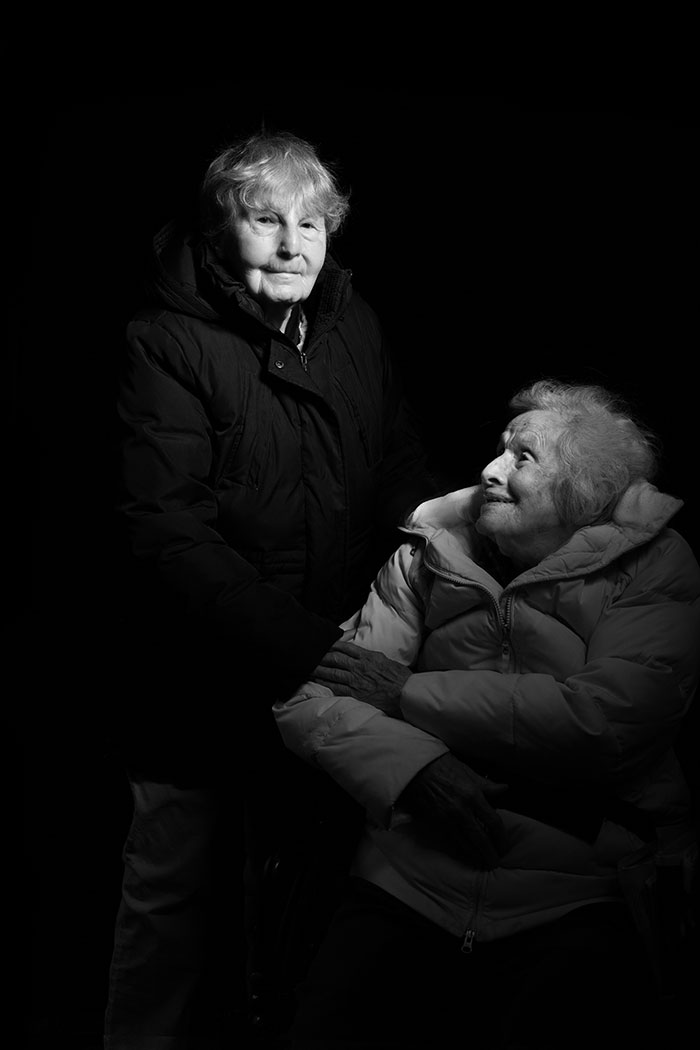
Van Sise’s farthest drive was to Southern California, where Sam Silberberg, a 91-year-old Auschwitz survivor, challenged him to a hike on the local hills followed by arm wrestling. Agile and muscular, Silberberg led the way across rocky trails, with Van Sise trudging behind with his assistant, camera equipment in tow, while trying not to slip. Later, Silberberg, whose forearm had been tattooed in Auschwitz when he was enslaved at age 10, won their arm wrestling contest.
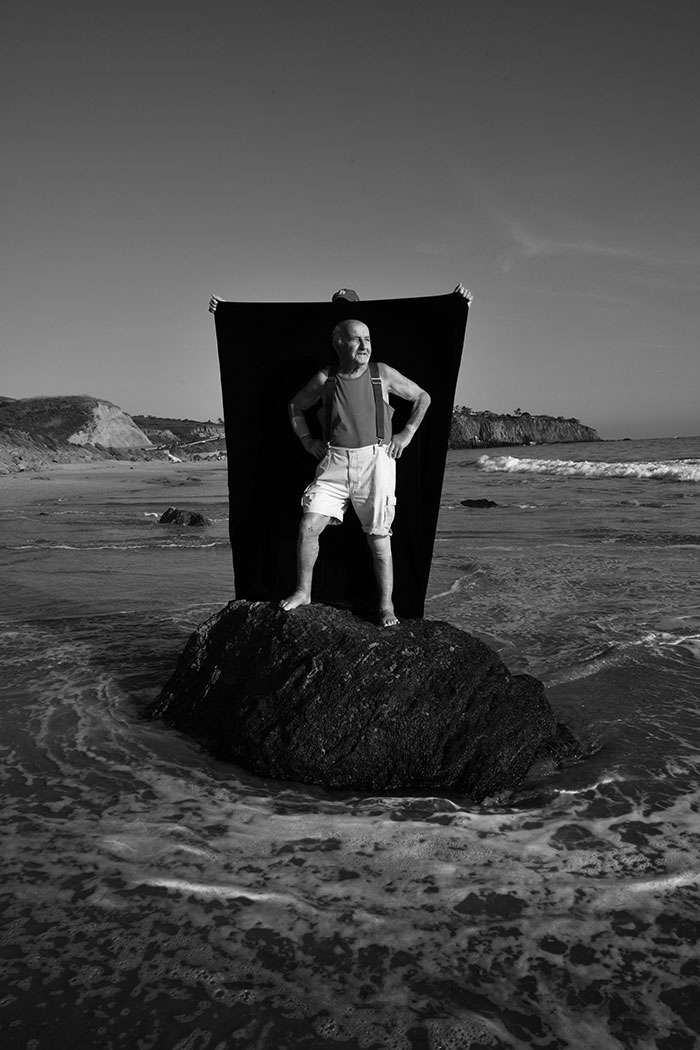
During each of these encounters, Van Sise spent at least three to four hours with the person, first listening, then using his Nikon 850 to preserve their image on film. He wanted to show them in a simple setting; for the most part, he photographed each person inside their home. The resulting images are black and white, each survivor distinct under a soft light, a lyrical rendering. After each meeting, Van Sise wrote the vignettes that would accompany the image, the survivor’s voice still fresh in his mind.
In Invited to Life, an Auschwitz survivor becomes a bespectacled magician, a puff of smoke rising from his palm; a concentration camp survivor becomes a musician pounding at one of his drum sets, cymbal quivering; a boy who once escaped a death march becomes an athletic warrior standing barefooted on the beach after conquering the hills of Southern California.
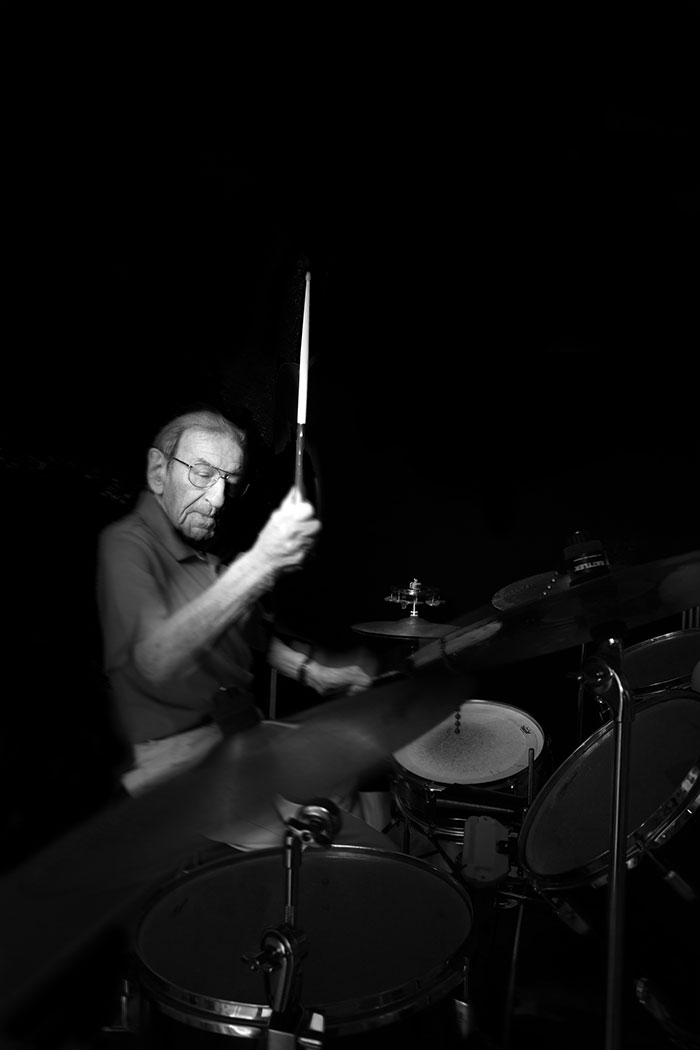
‘We Are Going to Live in This Book Forever’
Van Sise’s journey to chronicle these lives came in the nick of time. The youngest Holocaust survivor alive today would have been born 78 years ago, just as the war ended. Several of those featured in Invited to Life have died since posing for the book. Werner Reich, the magician, died on July 8, 2022, at the age of 94.
Yet at the standing-room-only book launch in February, a swath of Holocaust survivors and their families flocked around Van Sise. At the Strand’s Rare Book Room in Manhattan, he ran a panel with two of the subjects featured in the book: fellow Fordham alumnus Michael Bornstein, PHA ’62, and Tova Friedman.
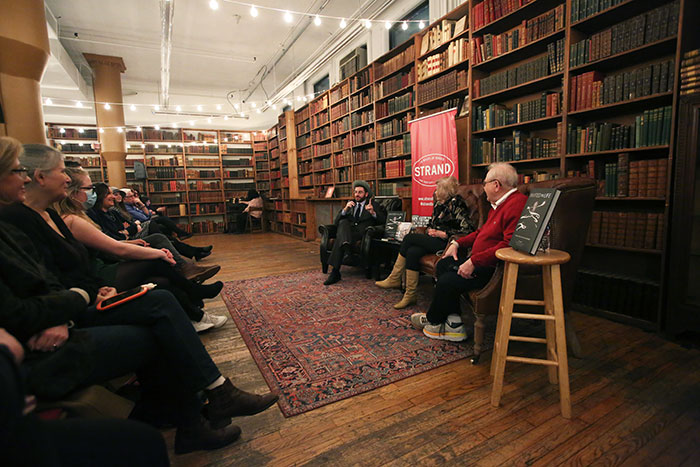
On stage, Friedman and Bornstein, who’d been photographed together as children liberated from Auschwitz, riffed off each other and Van Sise. Bright and charismatic, they were optimistic, even as shadows of their tortured past lingered. Bornstein’s recollections of his childhood are dim, he told Fordham Magazine in 2017, “a blessing and a curse.” He was 4 years old when he was tattooed in Auschwitz. After the Soviets liberated him, Bornstein was reunited with his mother, but his father and older brother were murdered in a gas chamber.
At age 10, Bornstein and his mother emigrated to the United States. He’d go on to earn a partial scholarship from Fordham, work odd jobs throughout his studies, and eventually earn a Ph.D. in in pharmaceutics and analytical chemistry from the University of Iowa. Still later, he’d write a New York Times bestselling memoir.
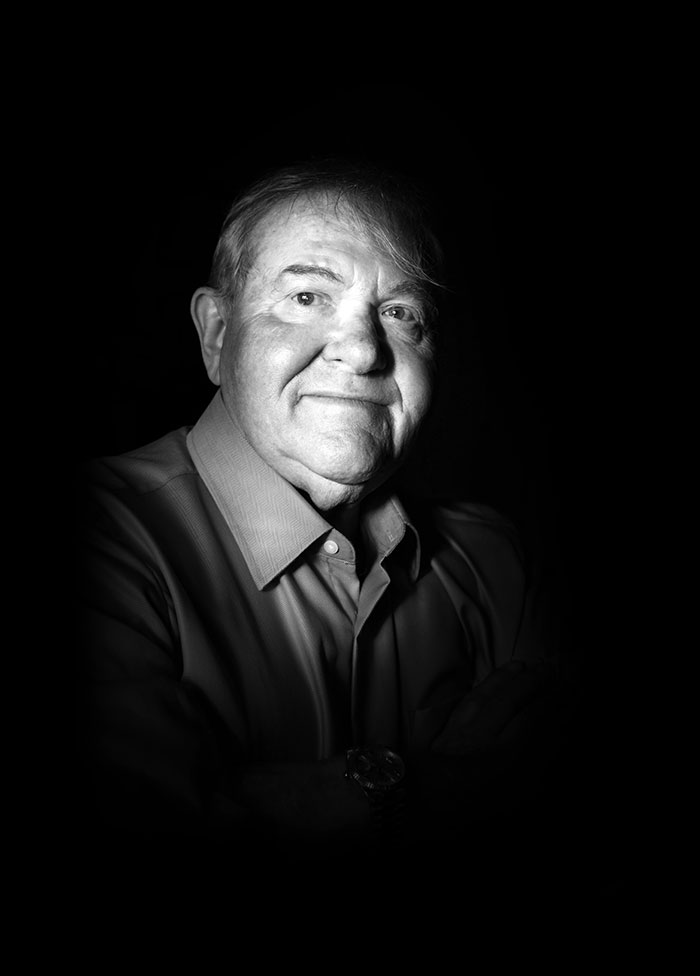
Friedman, who by age 7 had experienced starvation and been hidden among piles of corpses, was lucky: She survived the war alongside her mother and was reunited with her father. After emigrating to the United States with her parents, she earned an advanced degree, became a therapist, and started a family.
More recently, with the help of her grandson, Friedman has become a TikTok sensation, with more than 500,000 followers; one single post has amassed 8 million views. In two-minute videos, Friedman answers questions about the Holocaust from among the hundreds she receives each week. Her eight grandchildren are her legacy, she said, but Van Sise’s book is now part of her legacy, too.
“We are going to live in this book forever,” Friedman said. “We’ll be there forever with our stories.”
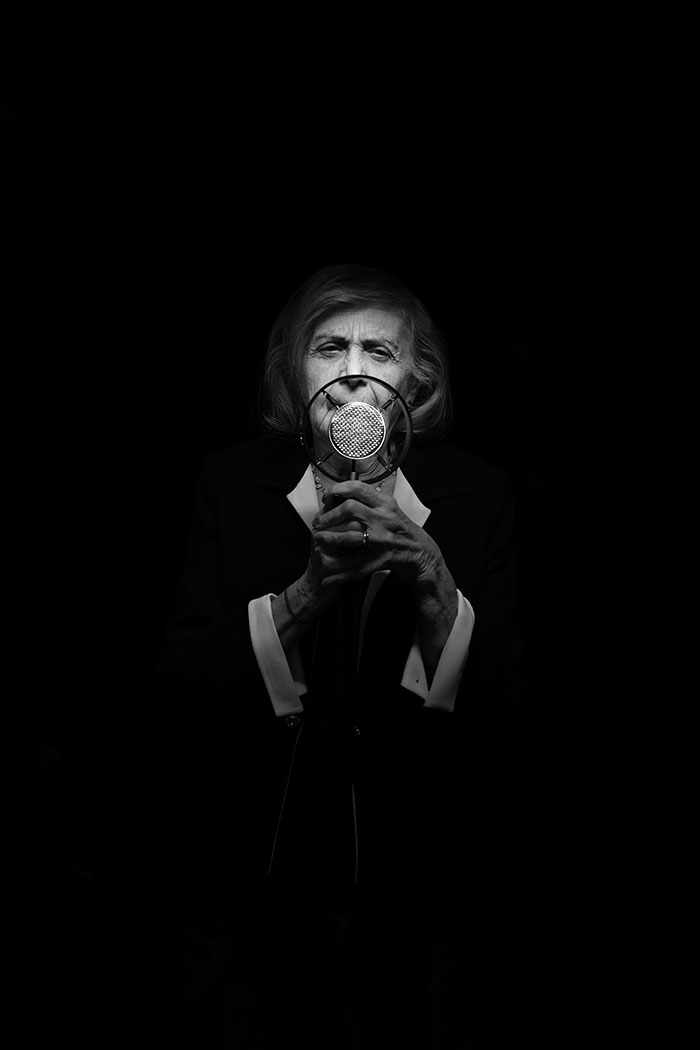
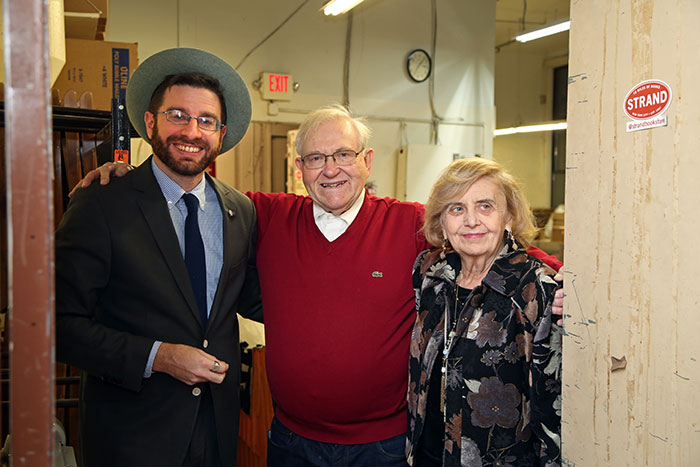
‘Soul-Fullfilling’ Projects
Sitting across from Bornstein and Friedman at the Strand event, Van Sise seemed to have accomplished what he unknowingly set out to do. When he had arrived at Fordham as an undergraduate about two decade ago, he’d intended to study early Christian theology. But in his first year, he responded to a Craigslist ad for The New York Sun seeking a cub reporter or photographer. He got his father’s old Canon FT and launched a career.
He credits Joseph Lawton, his photography professor, for changing his life and inspiring his career. Lawton, who’s taught photography at Fordham for more than 40 years, has a relatively simple philosophy. He asks students to find beauty in their own lives, to enjoy the simple pleasure of sight, and then share what they see.
“If you look even now at his work versus mine, you will see there is a kinship there,” Van Sise said. “He also has a certain sense of the poetry of life, and the little moments.”
As Van Sise travels the country to promote Invited to Life, he continues to meet with the survivors whose lives he’s recorded inside the pages of his book. Together, they speak at panels and receptions. For Van Sise, it has been among the most “soul-fulfilling” projects of his life.
His next production, a film slated to appear as major museum installation in the fall of 2024, will portray disabled American veterans, a group he feels a particular kinship with, having served in the U.S. Coast Guard Reserve and having a father and grandparents who served in the Navy and Army, respectively.
Naturally, he has more on the burner. Lately, Van Sise has been documenting speakers of 80 endangered languages across America. In this creation, he is incorporating language, poetry, and images—to remind us, once again, not to forget.
—Keren Blankfeld is a long-form journalist who teaches reporting and writing at Columbia Graduate School of Journalism. Her book Lovers in Auschwitz: A True Story, based on a 2019 article she wrote for The New York Times, is scheduled for publication by Little, Brown in February 2024.

